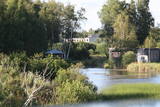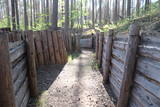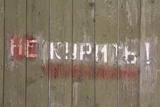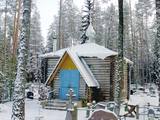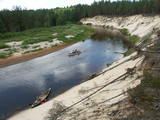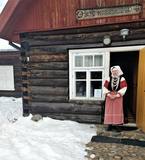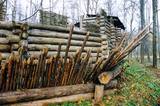| Nr | Nosaukums | Apraksts |
|---|---|---|
|
This is for people who enjoy forests, wildlife, local traditions and has a specific interest in the different species of funghi. Everyone could try their hand at mushrooming, identification and by the end of the day together with guide sort out the collected mushrooms. The tour passes several national parks and late back villages. The group will also visit to one of shitake mushroom growers for comparison reasons. |
||
|
Kafejnīca "Kukaburra" atrodas Rīgas - Veclaicenes šosejas (A2) 115. km. Iespējams apskatīt maizes muzeju un piedalīties maizes cepšanā, kas notiek katru nedēļas nogali. Latvisks interjers, mājražotāju un zemnieku produkti. |
||
|
19. gs. otrajā pusē starp Dzeņu un Lielkalnu mājām izveidojās Vidzemes piekrastē viena no lielākajām kuģu būvniecības vietām - bijusī Ķirbižu (vēlāk – Vitrupes) kuģu būvētava, no kuras līdz mūsdienām nekas dabā vairs nav saglabājies. No 19. gs sešdesmitajiem gadiem līdz 1929. g. šajā vietā tika uzcelti 28 kuģi. |
||
|
Lībciema tuvumā izvietotā bijusī militārā teritorija netiek izmantota un precīzs tās kādreizējais pielietojums nav noskaidrots. Privāta un slēgta teritorija. Gaidām kādu stāstu!
|
||
|
Ar Kara muzeja informatīvo atbalstu Garā kāpā pie Antiņiem ir rekonstruēta daļa latviešu strēlnieku nocietinājumu sistēmas. Aspkatāmas ierakumu pozīcijas un vairākas zemnīcas. Netālu atrodas bijusī un no dzelzsbetona veidotā medikamentu glabātuve. |
||
|
This is the most challenging Forest Trail section, especially on the second day. Here, on the coast of the Gulf of Finland, rises the North-Estonian Klint – a steep, rocky and forest-covered cliff that stretches non-continuously to Tallinn and further to the islands of West-Estonia. The Forest Trail runs on top of the cliff and occasionally descends into valleys. It crosses the deep and vast Pühajõgi valley in Toila-Oru park and comes to Toila, a popular coastal resort. One of the most unusual sections of the Forest Trail in Northern Estonia, which leads along the foot of the impressive North-Estonian Klint in good weather, then climbs to the top of the klint in the villages of Valaste and Saka, revealing breathtaking views of the Gulf of Finland. |
||
|
Dabas saldumu maģijā saimniece ir Ilze Kupča. Ilze gatavo kūkas un tortes, zefīrus, vafeles, pīrādziņus, plātsmaizes, ruletes, konfektes, u.c. Gardumi tiek gatavoti no īstiem lauku produktiem - no Latvijas zemniekiem. Daudz izmantotas ogas - no mājražotājiem, pašu audzētas vai salasītas mežos. Ilze no vecmāmiņas mantojusi viņas kūku recepti ar nosaukumu “Vecmāmiņas mantojums”. |
||
|
Saimniecībā apskatāmi vairāki dzīvnieki - zirgi, kazas, truši, suņi, kaķi un murkšķi. Ir iespēja iesaistīties lauku darbos un iemēģināt darbarīkus, iemācīties seno deju soļus, izstaigāt dzīvnieku takas un baudīt uz ugunskura ceptas pankūkas ar kazas pienu. Saimniecībā pieejamas arī pirtslietas un zāļu tējas. |
||
|
Plaša teritorija dienvidos no Pāvilostas, kur izvietotas kādreizējās padomju armijas apvienotās noliktavas un naftas bāze. Pašlaik teritorija tiek izmantota celtniecības materiālu ieguvei un kā kokapstrādes darbnīcas. Pie teritorijas izvietotas brīdinājuma zīmes "Bīstami, apdraud dzīvību", kas jārespektē!
|
||
|
Maltas (Rozentovas) Visusvēto pareizticīgo baznīca uzcelta
1928. gadā. Tā ir koka guļbūve ar dubultiemlogu rāmjiem un sīpolveida
kupolu, fasādēs – stilizēts saules motīvs.
|
||
|
Vilsandi nacionālā parka „sirds” un divpadsmitā lielākā Igaunijas sala (garums - 6 km, platums – 2 km). Tā ir ļoti „jauna” sala, kas sākusi veidoties pirms ~ 2000 gadiem zemes garozas celšanās rezultātā, savienojoties divām salām, kas noticis pirms ~ 350 gadiem. Cilvēki salu sāka apdzīvot 18. gs. un to galvenā nodarbe bija zvejniecība, kuģu būve, nelielā apjomā – lauksaimniecība. Līdz 2. pasaules karam te bija ap 200 iedzīvotāju, kuri vēlāk salu bija spiesti pamest PRSR pierobežas režīma zonas dēļ. Nozīmīgu Vilsandi daļu aizņem mežs un kadiķu lauki. To visā garumā šķērso grantēts - zemes ceļš ar atzariem uz jūras krastu. Salu ar kājām var izstaigāt vairāku stundu laikā, iepazīstot vietējo apbūvi (daļa arī mūsdienās celtas ēkas) un Tolli sētu, kur pēc nostāstiem dzīvojis nīderlandiešu jūras braucējs Johans Dolls, kā arī vējdzirnavas. Noteikti ir jāaiziet līdz salas rietumu krastam, kur atrodas Vilsandi bāka un bākas uzrauga saimniecības ēkas. No šejienes ir labi redzamas Vaikas salas. Šodien uz salas pastāvīgi (visa gada garumā) dzīvo tikai trīs cilvēki. |
||
|
Salīdzinoši liela teritorija dienvidos starp Irbes un Stendes upi, kas unikāla ar mazskartajiem mežu masīviem, kāpu veidojumiem, Irbes vecupju sistēmu un iegareno, piekrastei paralēli izvietoto Dižpurvu. Irbe pēdējo gadu laikā ir kļuvusi par samērā populāru ūdenstūrisma galamērķi, taču tās krastos, diemžēl vēl aizvien ir nepietiekama ar tūrismu saistītā infrastruktūra. Tā kā liegumu caurauž blīvs meža ceļu tīkls, tā ir potenciāla vieta dažādām dabas un izziņas tūrisma aktivitātēm. |
||
|
Restorāns "Kapteinis&Grants" atrodas pie viesu nama „Villa Elizabete”. Sezonas laikā darbojas vasaras terase, bet aukstā laikā maltīti var ieturēt kamīnzālē – bibliotēkā. Latviešu virtuve: Marinēta Baltijas siļķe ar biezpienu, baraviku krēmzupa, grilēta cūkgaļas karbonāde, jaunlopa gaļas steiks, grilēts līnis. Īpašais ēdiens: Kapteiņa Granta siera kūka. |
||
|
The Baltic Sea littoral on the West coast of Kurzeme is called the Great Wave Sea. The seacoast is mainly sandy. While the Great Wave Sea section is the least populated coastal area in Latvia, at the same time, the third biggest city in Latvia, Liepāja, is also located there. Steep bluffs rise before your eyes on the seacoast between Pāvilosta and Sārnate. The villages are quiet and sparsely populated. At the beginning of the route, you can see the Soviet military heritage in Liepāja Karosta Prison, taste smoked local fish in Pāvilosta and then enjoy one of the most beautiful views of the entire route to the seacoast from Užava lighthouse. The route closes in the port city of Ventspils, where there are various entertainment and sightseeing places, especially for families with children. |
||
|
Pie Aizkraukles luterāņu baznīcas gar Daugavas senlejas krasta augšdaļu saglabājies neliels vecā ceļa fragments, no kura (īpaši – bezlapu) periodā atklājas viens no skaistākajiem Daugavas vidusteces skatiem. Aptuveni kilometru ziemeļrietumos slejas Aizkraukles pilskalns ar ne mazāk iespaidīgu skatu.
|
||
|
Salas mazākā un dekoratīvo elementu ziņā - viena no Ziemeļeiropā bagātākajām baznīcām. Savu izskatu maz mainījusi no celtniecības pirmsākumiem (14. gs.). |
||
|
„Strauti” atrodas Embūtes pauguraines austrumu malā. No dienvidiem tos ieskauj plaši mežu masīvi, kuros mīt daudzi Latvijas savvaļā sastopamie dzīvnieki. Blakus saimniecībai atrodas bijušās putnu fermas korpusi. Saimniecībā audzē vaislas trušus, aitas, dažādu šķirņu mājputnus, divus zirgus un poniju. Saimniecības laukos ganās govju ganāmpulks, kurā starp dažādu šķirņu govīm apskatāmas arī Latvijas Zilās govis. Saimniece piedāvā ekskursijas skolēnu grupām un citiem interesentiem. Iepriekš vienojoties, iespējama trušu gaļas, aitas vilnas, kā arī saimniecībā izaudzēto dārzeņu iegāde. Bioloģiskā saimniecība. |
||
|
Šis ceļojums jums ļaus atklāt Kurzemes reģionu un tā tradicionālos ēdienus. Maršruta sākums ir Rīga, tālāk dodoties ārpus tās, pa brīnišķīgām pastaigām dabā, kas pēcāk palielinās jūsu ēstgribu. Jums būs iespēja izgaršot tradicionāli kūpinātās zivis zvejnieku saimniecībā "Dieniņas", piedalīties burkānu pīrāga - sklandrauša - gatavošanas meistarklasē, iepazīt zivsaimniecības un ciematus Slīteres Nacionālajā parkā, kā arī baudīt izsmalcinātas maltītes Ventspils pilsētas krodziņos. Dodoties mazajā ceļojumā, ir jāizbauda ikkatrs mirklis, tostarp, jāpiestāj ievērojamākajās apskates vietās. Viena no tām - Kuldīgas vecpilsēta, arī Jūrkalnes stāvkrasti. 19. gadsimtā būvētajās ūdensdzirnavās, kas mūsdienās funkcionē kā bioloģiskā saimniecība, jūs laipni uzņems un dos iespēju piedalītes ēdiena gatavošanas meistarklasē, tās pamatā - tradicionālie ēdieni, sastāvdaļas kā foreles, dārzeņi, augļi un medījumu gaļa iegūtas turpat, saimniecībā. Pēdējā pieturvieta pirms došanās atpakaļ uz Rīgu - Pūres Šokolādes muzejs. |
||
|
While you are in Obinitsa Seto Museum you can learn more about the lifestyle and culture of Setomaa's people. In the museum you can see a lot of items that are very important to their culture, for example the fine handicraft of the Seto women. Also since 2015 here you can also learn about other Finno-Ugric nations. There is a possibility to shop in the souvenir shop. |
||
|
Atrodas Lielvārde centrālajā daļā, Rīgas - Daugavpils šosejas (A 6) malā. Latvijā šobrīd vienīgais šāda veida objekts - 12. gs. senlatviešu koka pils atdarinājums, kas tapis mākslinieka Agra Liepiņa vadībā. Tās vizualizācija ir balstīta uz dažādās Latvijas vietās atrasto seno būvju atlieku izpētes rezultātiem kā autora versija par Lielvārdes novada vecākā - Uldevena rezidenci. Koka pils iekšpusē var apskatīt 12. - 13. gs. senlatviešu cietokšņa aizsargbūvju un dzīvojamo ēku imitācijas, seno tērpu rekonstrukcijas, kā arī pašiem uzcept desiņas uz ugunskura. Kāziniekiem tiek piedāvātas dažādas atrakcijas. |
||




